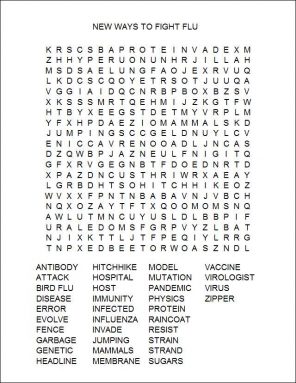New ways to fight the flu
Influenza viruses evolve constantly, but so does flu science
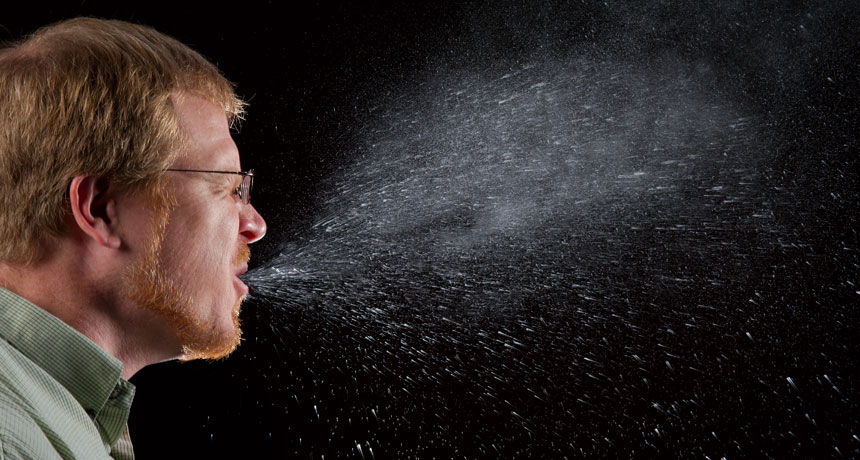
The flu virus infects the nose, throat and lungs. It can be spread when an infected person coughs or sneezes. This is why you should always cover your mouth when coughing or sneezing. The plume of saliva droplets expelled during a sneeze usually is not visible — but it’s there.
CDC/James Gathany/Brian Judd
Share this:
- Share via email (Opens in new window) Email
- Click to share on Facebook (Opens in new window) Facebook
- Click to share on X (Opens in new window) X
- Click to share on Pinterest (Opens in new window) Pinterest
- Click to share on Reddit (Opens in new window) Reddit
- Share to Google Classroom (Opens in new window) Google Classroom
- Click to print (Opens in new window) Print
You go to bed feeling fine. The next morning you’re sick with a fever, exhaustion, headache, body aches and more.
You may have influenza, better known as the flu. It’s caused by a virus, a tiny bit of genetic material surrounded by a protein. Flu viruses infect the nose, throat and lungs. (If people claim to have “stomach flu,” they are mistaken. They really have some other infection.)
Every year, between 5 percent and 20 percent of all Americans come down with the flu. Those numbers come from the U.S. Department of Health and Human Services in Washington, D.C. Complications send more than 200,000 of these flu victims to the hospital each year. Worse, the flu kills anywhere from 3,000 to 49,000 people annually — and that’s just in the United States.
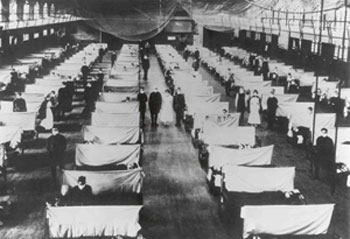
A widespread outbreak of flu or another infectious disease is called an epidemic. In some years, flu spreads so far and so fast that it causes a worldwide epidemic. This is known as a pandemic. Researchers hope to prevent a pandemic if possible. One tactic: vaccines.
Flu vaccines offer people some immunity. Immunity is the body’s ability to resist a particular disease by making proteins called antibodies. A vaccine can give that process a head start. However, no vaccine yet can fight all types, or strains, of flu.
What’s more, notes David Morens, “Flu is not one virus. It’s many, many viruses.” Morens works at the National Institutes of Health in Bethesda, Md. As an epidemiologist, he studies the causes, patterns and effects of disease in populations.
Flu viruses constantly evolve. That means their genes undergo change. Those changes are called mutations. And some mutations can let a virus evade any immunity, says Morens. Each year, the flu vaccine is updated to keep up with those mutations. The vaccine targets strains based on what health experts saw happening with different strains the previous flu season.
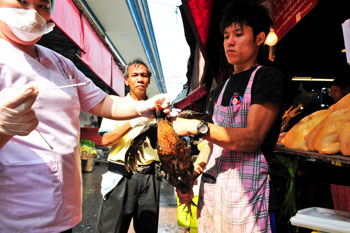
Recently, an usually high percentage of changes happened in one type of flu virus, known as H3N2. As a result, the vaccine for the 2014 to 2015 flu season didn’t work well. In fact, the vaccine was only about one-third as effective as a well-matched vaccine would have been. Scientists from the Centers for Disease Control and Prevention and other organizations reported the results this past January 16 in Morbidity and Mortality Weekly Report.
Recently, health officials decided the vaccine for the upcoming flu season in the United States will include the H3N2 “Switzerland” type that made this year’s vaccine a poor match. It will have a new “Type B” strain as well. But new mutations keep occurring. Vaccines are “always a little behind,” Morens notes.
Now science aims to get ahead of the flu. Some researchers are trying to gauge how flu evolves. These experts want to know what strains are likely to strike hard and soon. Others are searching for vulnerabilities common to all types of flu. Still other scientists are looking for ways to stop new flu strains before they can easily infect people at all.
Constantly evolving
Katia Koelle is a biologist at Duke University in Durham, N.C. She says that one reason researchers have trouble keeping up with new flu types is the fact that these infections are caused by an RNA virus. RNA is short for ribonucleic (RY-boh-nu-KLAY-ic) acid. Cells grow and act by making specific chemicals called proteins. Cells do so at the right time and the right place with a type of RNA.
Like that RNA, a flu virus has a single strand of genetic material. Once in host cells, the virus gets the cell to copy its genetic code over and over to make more virus.
But “mutations arise all the time in flu,” Koelle notes. Here is one big reason: RNA viruses “don’t have proofreading mechanisms.” So they don’t detect a mistake and correct or eliminate mistakes that copying errors introduce. If the error doesn’t kill the virus, the affected RNA will show up in future generations. Such errors will get copied over and over whenever the virus reproduces. It’s like a printing press spitting out thousands of newspapers with the same misspelled headline.
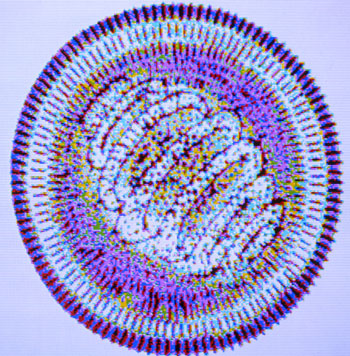
That’s different from DNA viruses, a family that includes the one that causes chickenpox. When DNA reproduces, each bit on its double strands can partner only with a specific part on the other. It’s like a zipper. Each half has to pair with the other half. If there’s a snag, the process stops. Without that check, RNA viruses can get “sloppy,” Koelle says.
Researchers want better ways to predict which flu strains will hit people hardest next year. To do that, researchers at the University of Cologne in Germany and Columbia University in New York City have made a computer model. This computer program has equations, program instructions and data for thousands of strains of H3N2 (a common flu type).
The team focused on the gene for a protein found on the surface of the flu virus. That protein is hemagglutinin, or HA. HA helps the flu virus hook onto host cells. Antibodies can prevent HA’s action. But those antibodies work only if they can latch onto HA just right. Think of it as a matching lock and key set.
The researchers asked the computer model to sift through and find those strains least likely to encounter matching antibody “keys.” If few antibodies could lock up these virus strains, most people would be at risk of becoming infected by them.
“Basically, the rarer it’s been in the past, the better” a flu strain will do, says Koelle. She reviewed this study that used computer modeling before Nature published it in March. If new vaccines targeted those strains, the vaccines would equip more people with effective antibodies. Fewer people should then get sick from those strains.
Of course, new flu strains will still evolve. But the hope is that each year’s modeling will flag them early.
How viruses morph
Koelle also uses computer modeling to study how viruses evolve. Some mistakes in copying the RNA code can doom a virus. But about 8 percent to 10 percent of those RNA changes help the virus survive, she says. These survivors might then infect more people.
Other RNA changes are what Koelle calls “garbage” mutations. They don’t kill the virus. Still, these mutations can make the virus less likely to survive and reproduce. About 40 percent of mutations in RNA viruses fall into that “harmful” category, she says.
One of Koelle’s projects looks at links between “garbage” mutations and other mutations that give flu strains an edge. Remember that when the flu virus reproduces, all its genetic code gets copied, unless more mutations occur. Thus, an RNA change that helps a flu virus survive and spread means there will be more reproduction of its genetic code, including any “garbage” mutations. Koelle says it’s as if a bad student copies someone’s homework. That student will aim to copy everything, including both right and wrong answers.
Even though the “garbage” mutations carry forward into future generations, they might still “shape some patterns of evolution,” Koelle notes. For example, these changes might affect the rate of future mutations. Or the changes might affect where and how a virus spreads among people. Ideally, understanding the “garbage” could lead to new ways to fight flu.
Another computer-modeling project focuses on changes that might help the virus more quickly find host cells. “Once it’s in the host cell, an antibody can’t get it,” Koelle explains. Getting into host cells more quickly thus lets a virus strain “run and hide faster” from antibodies, she says. Computer modeling with data from work by other researchers could give clues about how those mutations work. Knowing that could help researchers figure out better ways to defeat the viruses with vaccines.
Universal solutions?
Viruses can’t reproduce by themselves. Instead, they must invade the cells of another organism. Once inside, a virus turns the cells of its host into virus factories. Researchers are using another computer model to look at how that process starts. It focuses on the steps the HA protein goes through as it attaches to the outside of a new host cell.
“From experiments, we know that HA folds into two different structures— one before it connects [with a host cell] and one after,” explains Jeffrey Noel. He’s a biological physicist at Rice University in Houston, Texas. Noel and his team created a computer model that uses physics principles to figure out how the refolding happens.
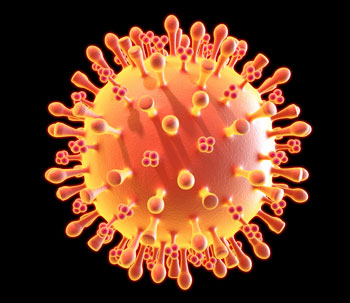
Before it latches onto a host cell, the HA protein can have any of several shapes. Again, some of those variations can keep antibodies from working. As noted before, the protein and antibodies must fit like a lock and key.
Meanwhile, the inner part of the HA protein pretty much stays the same from one type of flu virus to the next. “The virus can’t mutate that part of the protein very much,” Noel says. And it’s that inner part of the protein that lets the virus invade the cell.
As HA refolds, the protein exposes that inner part. Experts see this as a vulnerability. That exposure might be a chance “to go inside the fence and attack” the protein with a medicine, notes Noel. And since that part of the protein generally doesn’t change, such a medicine might work against many types of flu, he says. His team published its findings in the August 19, 2014, issue of the Proceedings of the National Academy of Sciences.
Still other research asks basic science questions about “what flu viruses do and how they do it,” notes Morens. For example, ducks and other birds naturally harbor flu viruses (often with no sign of disease). “How does a bird virus get to be a human virus?” he asks.
Changes that let flu viruses move from another species into humans are relatively rare. Yet those rare mutations pose big threats. When transfers happen, no one will have immunity for quite a while. If a new strain spreads very quickly among people, it risks becoming a pandemic.
Flu’s migrations
Flu doesn’t just move from birds to humans. Bird flu also can go to pigs or other mammals. Scientists at St. Jude Children’s Research Hospital in Memphis, Tenn., and other organizations found one form had infected harbor seals in 2011. That strain most likely came from a wild sea bird, notes Stacey Schultz-Cherry. She’s a virologist at the Memphis hospital.
Viruses infect animal cells by binding to sugars on their surface, or membrane, Schultz-Cherry explains. “These bird viruses typically can’t get into the cells” of mammals. That is because birds and mammals have different sugars on their membranes.
Schultz-Cherry compares it to trying to pick out someone in a crowd. If you’re told to “look for a guy in a yellow raincoat,” you know whom to look for. That is true even if you haven’t met the person before.
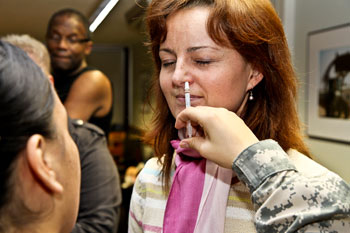
In this case, though, the bird virus changed. It found a way to recognize the sugar on seal cells. Nature Communications reported her team’s findings on September 3, 2014.
“No human illness was linked to the 2011 harbor seal virus,” Schultz-Cherry says. However, scientists think infected seals did transmit flu to people in the 1880s. And flu can indeed pass into people from other types of mammals. Flu also can go from people into other mammals — and maybe even back again. A study in the August 2014 Journal of Virology showed that human flu can infect dogs, for example.
“There must be some kind of host-switching process,” Morens says. But right now, “we have no idea how that happens.”
For one thing, genetically, bird viruses look very different from human viruses. Also, a virus can’t survive long outside a cell. Scientists are now scouting for various in-between hosts. But with so many strains and mutations, finding a host-jumping virus can be like looking for a needle in a haystack.
Lab studies can explore, in a more orderly way, how flu viruses evolve. Some studies start with a bird flu virus and work forward. Researchers alter the virus’s genetic code and see whether the change lets the virus infect a mammal, such as a ferret.
Other lab studies work backward. Suppose your research team finds 100 differences between a human virus and the bird virus that was its likely source. “Then you start one by one getting rid of each mutation and see what happens,” says Morens. How does each change to the virus affect its ability to infect human cells?
Repeating the process over and over could show steps in the host-jumping process. “We want to know what those steps are,” says Morens. That will provide a general picture “of how the evolution occurred.”
Once scientists know that, they might find a way to stop the process before people get sick. Meanwhile, other researchers continue the search for better vaccines. Perhaps you might help make some of these important discoveries. “We desperately need more people in science,” says Schultz-Cherry.
In the meantime, good health habits can cut our risk of becoming infected. “Wash your hands,” Schultz-Cherry recommends. And get your flu shot, she adds. Tell your family members to do the same. Eat healthy foods and get enough sleep too. These are ways all of us can help fight the flu.
Word Find (click here to enlarge for printing)
